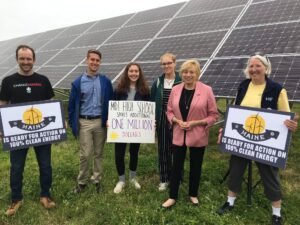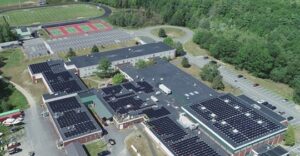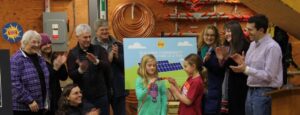Focusing on Solutions: Mount Desert Island’s ‘A Climate to Thrive’
By Kaitlin Cough
Wildfires in Australia. Floods in Idaho. Spindly corpses of polar bears in the arctic and whole hives of small dead bumble bees.
The effects of climate change are local and global; discouraging and infuriating. They are also overwhelming.
“You don’t have a sustainability coordinator built into your life,” said Johannah Blackman, a founding member of the Mount Desert Island (MDI) nonprofit A Climate To Thrive (ACTT).
“You get up, you feed your kids breakfast, you go to work, you come home, you eat dinner, you’re exhausted. You don’t have time to be researching ‘How can I make my home more efficient? How can I afford solar panels? How can I afford an electric vehicle?’ For someone to come in and offer the opportunity to implement solutions and a toolkit of sorts,” said Blackman, “People are psyched.”
Blackman has been involved in climate activism for more than a decade. Much of that early work was focused on marches and protests, which she still wholeheartedly endorses (“We absolutely need national and international systemic change”) but in 2015, pregnant with her first child and living on MDI, “I really wanted to start actually making solutions happen on the ground. I wanted to be able to look at my kids and say I did everything I could.”
The group that became ACTT began as the MDI Climate Solutions Group, “Because we wanted to focus on implementing solutions,” said Blackman.
And so they have. With a goal of making MDI energy independent within the next decade, ACTT has racked up a number of successes: solar panels on the high school (the largest array on a public school anywhere in the state), new electric vehicle charging stations around Hancock and Washington counties, increasing solar on MDI by 450%, pledges from local businesses to replace single-use plastics and polystyrene containers, and a lot of involvement from local students, including a thriving intern program. The list (which is extensive) can be found on the group’s website, aclimatetothrive.org.

“We wanted it to be an ambitious goal,” said Blackman. Translating ambitious goals into action, she conceded, “Is difficult for national and international bodies. But it’s a lot easier at the local level.”
So how did they do it?
By involving as many community members as possible, by staying focused on solutions, and by listening: to experts, to local officials, to school board members and teachers. And, of course, to their neighbors.
The group began in the summer of 2015 with monthly potlucks for anyone who wanted to come. The idea was to start a conversation, “to get people together to talk about what we could do and how people were feeling.”
Organizers, including Blackman and her husband Dennis Kiley, along with residents John Craigo and Gary and Glennon Friedmann, who first began discussing the plans, pooled their contact lists and invited everyone they knew.
“Most of the people that we’ve approached have been so eager to find solutions and to have the opportunity to think about climate change in a hopeful way,” said Blackman. “They’re just overwhelmed in their daily lives.”
“Most of the people that we’ve approached have been so eager to find solutions and to have the opportunity to think about climate change in a hopeful way”
As the group continued meeting, focus areas began to emerge: alternative energy, zero waste, building efficiency, transportation, food systems and public policy.

“We wanted to bring the community together as early as possible around this so that the whole island would own the project,” said Blackman. “It was really important very early on that we had a public event that anybody could come to.”
On a Sunday afternoon in January 2016 they did just that: instead of watching the Denver Broncos beat the Patriots in the American Football Conference championships, more than 200 residents gathered at the Neighborhood House in Northeast Harbor to talk about what they and their communities were going to do about climate change. Venu Rao, the day’s keynote speaker, gave a speech on Hollis, N.H., a largely conservative town that’s become a leader in energy efficiency.
“Our message is — we’re not trying to save the world,” Rao told the group, according to a Maine Public Radio report. “We’re trying to save the money and we’re also appealing to them that we need to live sustainably, that you don’t have to be conservative or Democrat to do that, you know?”
After the speech, residents broke into groups based on the six focus areas. They could join any area that grabbed their interest. Each table had a scribe, a moderator and an expert on the topic.
“We opened it up to talk about possible projects in each focus area,” said Blackman. “It’s so wonderful to have a large group because you have people with expertise and knowledge and talent in different areas, people who show up with different strengths.”
The launch not only gave ACTT visibility and allowed them to hear what kinds of projects their neighbors thought were important, it also gave them emails, and lots of them.
“We left each of those breakout sessions with an email list of people who were interested in that particular area and some key plans and connections to start with and we followed that up with monthly meetings with each of those committees,” said Blackman.
The committee structure lasted “about a year and a half,” she said, until “It just became evident that we had enough projects going at that point.” They wanted to make sure that good ideas, said Blackman, didn’t “get bogged down in just the planning phase.”
In the meantime, the organization’s structure began to formalize: they brought on a board, applied for nonprofit status and hired their first staff member.
“When you start as a grassroots organization and you keep going and become this project-focused, much more organized effort, you have to go through this metamorphism process,” said Blackman, “shifting from that grassroots energy of ‘go get em’ to ‘okay, how do we go get em?’ and putting structure in place.”
“When you start as a grassroots organization and you keep going and become this project-focused, much more organized effort, you have to go through this metamorphism process, shifting from that grassroots energy of ‘go get em’ to ‘okay, how do we go get em?’”
The members on ACTT’s board, said Blackman, have been key to that. “We made sure to bring people onto our board that had lots of experience in nonprofit organizations,” which helped the group envision what its structure might look like.
“We have a really good balance of people involved who have that entrepreneurial whatever it takes spirit, and people who are like ‘Okay, but we also need to really think about this,’” said Blackman. “Having that balance of energies and making sure those energies are communicating well is really key.”
The group also made a conscious choice not to spend much energy trying to convince residents that climate change is happening.
That was in part, said Blackman, because “It’s becoming more and more self-evident — the world is unfortunately doing that work for us. And the people who are really resisting that, we’re not going to convince them.”
Instead, they put their energy into listening, as non-judgmentally as possible.
“What we have tried to do is really be conscious of how we’re talking about this challenge to different people,” said Blackman.
“What really drew us in was not only how dedicated ACTT is to these issues, but how accessible they are trying to make it for everyone in the community,” said Nicole Cuff, co-owner of Sweet Pea’s Cafe.
“It’s extremely important to be as inclusive and reinforcing as possible when dealing with such a wide spectrum of businesses. The last thing anyone needs is to feel inadequate or too far behind the curve to get involved, and ACTT does an incredible job making the information and process attainable.”
“There are so many different reasons why people care,” said Blackman. Fishermen may be worried about their livelihood moving to colder waters; businesses might be worried about what climate change will cost them.
ACTT’s members, said Blackman, “Are really trying to think about what those reasons are and adjusting accordingly.”
ACTT, said Stacey Gatcomb, who manages The Looking Glass Restaurant, “has helped to make the sustainability pledge easier to achieve and maintain by listening to local businesses’ struggles in pursuing sustainability and working to find a solution.”
The group has helped the restaurant find sustainable options for dealing with food waste, energy audits and sustainable products, said Gatcomb, “and makes that information easily accessible.”
The Looking Glass is one of the 85 local food and lodging businesses that have taken ACTT’s “Sustainability Pledge,” in which businesses agree to opt for things like more sustainable food containers, using reusable containers for sit-down customers, and putting in water refill stations instead of providing bottled water.
85 local food and lodging businesses have taken ACTT’s “Sustainability Pledge”
“The sustainability pledge has encouraged us to push ourselves on this front and be an example not only in our community, but also a leader in our corporate family (Lafayette Hotels),” said Gatcomb.
“What drew me into the way ACTT is approaching problems is their focus on the end result, the empathy and trying to find solutions, and their support for businesses. ACTT touches the entire community,” said Gatcomb, “and I love the youth involvement.”

The restaurant was already looking to become more sustainable, said Gatcomb, but “Each year we are able to do more because of the work ACTT has done. Options that have not been possible in the past are now available because of the collective desire for a better product.”
That push for better products and spillover to other communities is something ACTT’s leaders have long been hoping for.
“It’s always been the hope that this would be an inspiration for others,” said Blackman, “Which is why we’re putting resources into spreading this model to other communities.” Work at the local level is vital and necessary, said Blackman, “But if just MDI does this, we’re screwed.”
“It’s always been the hope that this would be an inspiration for others, which is why we’re putting resources into spreading this model to other communities.”
That’s part of the plan for the group’s next phase, the Climate Resilience Partnership (CRP).
“It takes the experience that we’ve gained over the past four years and formalizes it into an island-wide initiative, which is what we’ve always wanted to do,” said Blackman. The partnership, in turn, will be shared with other communities.
Since ACTT began, “we’ve jumped at every low-hanging fruit that’s presented itself,” she continued. “Anywhere that we’ve perceived interest, we’ve cultivated it, we’ve gone in and acted as a catalyst to make projects happen.” That’s been helpful in understanding what the community needs and building relationships with schools, businesses, residents and local governments.
And hopefully it will help them take it a step further.
The group recently started in on round one of the CRP, in which ACTT members are approaching community groups, businesses, organizations, schools and towns and “working with each partner to develop their own plan for energy optimization, renewable energy and sustainable resource management,” said Blackman. That means understanding “How they manage their waste, what kind of products they’re using, are they composting?” ACTT is holding information-gathering meetings, said Blackman, and will then work with each partner on a sustainability plan.
“Where we listen to them, talk about what goals might look like for them, what incentives they hold, what challenges they might be facing that we’re not aware of — because we have no idea of how an entity like the local hospital works,” for instance.
Once the group has a better idea of each member’s needs, said Blackman, they will draw up a “first look” at options to make their work more sustainable and give them resources to support the plan.
“This project is our key project for the next few years,” said Blackman. “At the same time we’re documenting the process. We’re getting a lot of requests from other communities, so we’re going to formalize the process of delivering that toolkit, whether it’s through consultation or workshops.”
The nonprofit continues to grow, said Blackman, and offers a model for other communities. But it remains focused on solutions aimed at mitigating the very real impacts of climate change close to home: warmer, shorter winters and wetter springs, the flooding of low-lying roads during storm surges, increasingly unpredictable growing seasons, the lobsters moving increasingly northward to colder waters. As the evolutionary biologist Stephen Jay Gould noted, “We will not fight to save what we do not love.”
“We’re more focusing on what is happening to us on a day-to-day level and what might the future look like in the areas we care most about,” said Blackman. “What are some of the things that might mitigate that?”
For more information, or to get involved with Mount Desert Island’s A Climate to Thrive, visit aclimatetothrive.org. For resources on how to start a climate action group in your own town, visit their “Climate Action Starter Kit” at aclimatetothrive.org/general-resources.
Kaitlin Cough is a writer and photographer at The Ellsworth American.

